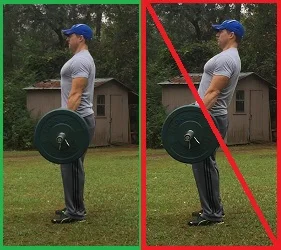Deadlift Back Angle
Angles play an important role when weight training (geometry *did* come in handy after all!). Too little here or too much there and your body moves out of place; when your body is out of place, you can't lift as much weight, you can become injured, or you end up performing an entirely different exercise. The back angle -- which is formed by the torso and the floor -- is largely dictated by the opening and closing of the hips; as the hips open, so too does the back. In a properly executed deadlift, the back angle stays relatively horizontal during the early phase of the pull. As the bar approaches the knees, however, things begin to change; it's at this point that the hips really start to extend and the back starts to appear vertical. Why is this important? If the back -- which remains isometrically contracted throughout the lift -- appears too vertical too early, you're likely sitting back and down, which looks and feels more like a squat. You'll have a problem lifting the bar up and around your knees in this position. If the back appears too horizontal later in the lift, you've likely opened your knees entirely without much hip extension, which looks and feels more like a good morning. You'll have a problem keeping the bar close to the body and lifting it to the the final position. Seen below are approximate back angles at the various stages of the deadlift. When you pay attention to the details and allow your body to do what it's supposed to do, you'll likely become stronger while experiencing fewer injuries. (You'll perform the proper exercise, too!)
Traps and Deadlifts
Have you ever woken up with sore biceps after a day in which you moved? Thinking back upon the loading and unloading of heavy furniture, you recall your arms being at a 90-degree, locked (isometric) position in order to carry couches up and down stairs and throughout rooms. Although you weren't performing bicep curls with a repeated up and down motion, you were still demanding a lot of work from these muscles through prolonged, strenuous contraction.
(This is our long-winded intro to why deadlifting builds the traps...)
Do you want strong, well-developed traps? (Traps are the new abs. Why wouldn't you want them to be bigger and better?!) Then you must deadlift! Deadlifting arguably helps develop this 3-part muscle more than any other lift on the planet.
The traps, like the biceps in the above example, must operate in a similar manner during this lift. The large muscle group, through isometric contraction, must withstand large amounts of weight pulling down on it and transfer force from the lower back up through the shoulders. They are liken to a beam supporting a bridge. The accumulation of reps, sets, and weight mean greater work; greater work results in a larger, more well-developed support beam for the body -- bigger, better traps!
So the next time you're picking up hundreds of pounds from the floor, just remember, your upper body is doing just as much work as your lower body. The deadlift is a valuable strength- and muscle-building tool for the traps.
Open Hips, Not Over Arch
Finish the lift right; don't injure yourself! A common problem for many deadlifters occurs at the end of the exercise. Yes, we absolutely want to finish the lift by standing up with the weight; but, unfortunately, some people illustrate its completeness by over emphasizing "open hips." A finished deadlift happens when the body is in alignment, from head to heel, and the hips are open, without a present crease (the picture on the left). It's when people take the openness too far and arch their back excessively (the picture on the right). When we have too much of an arch, a few things can take place, both leading to possible injury: it can overload parts of the spine, and it has the potential to cause misalignment of the hips. So, instead of leaning back a few extra inches, know that once you're upright and you have open hips, the lift has been successfully executed!
Bar Over Mid-Foot
To perform your best squat and deadlift, the bar must be placed over your mid-foot. Period. When it's too far forward, your weight goes toward your toes and you move forward. When it's back too far, your weight shifts away from mid-line and your torso leans toward the rear and becomes too upright. Either too far forward or too far back will result in diminished strength and a less-than-optimal lift. When the bar is directly over your mid-foot, balance is best maintained while force is maximally transferred. If you start the lift ahead of or behind this position, you must expend more energy than necessary to correct the position and get into proper placement. (Your chance of injury also increases when the bar is out of placement.) So be certain to start the lift -- decent for squat and ascent for deadlift -- with the bar directly over your mid-foot; and try to maintain this position throughout the exercise. By doing so, your chance to perform your best lift is ideal.



